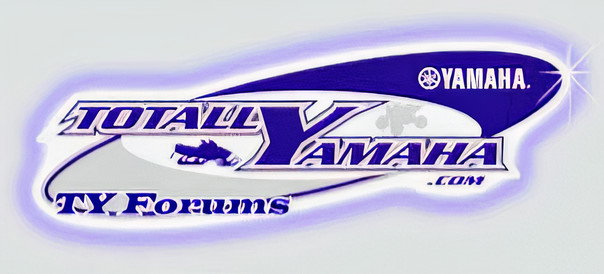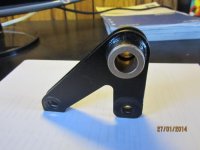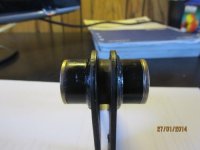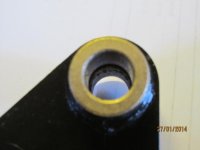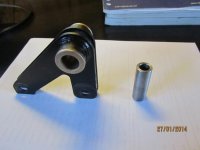fra settings adjust shock speed and stroke, they are not for adjusting for weight(sometimes can work out that way though)
lowest (bottom)setting is the fastest and longest stroke of the shock and spring, feels like the shock valving and spring are stiffer.
highest (top) setting makes the shock move slower and doesnt use all the travel of the sock, it feels like the spring and shock valving is softer.
shimming any bushing just needs to be between the bushing and the tube the bushing is in and no wider than the bushing.
lowest (bottom)setting is the fastest and longest stroke of the shock and spring, feels like the shock valving and spring are stiffer.
highest (top) setting makes the shock move slower and doesnt use all the travel of the sock, it feels like the spring and shock valving is softer.
shimming any bushing just needs to be between the bushing and the tube the bushing is in and no wider than the bushing.
I added instructions to install the skid easier, step by step. It is at the first page as well
loosen drive shaft bearing set screws
back off the transfer rod lower bolts 3/8in
back off rear idler adjustment all the way, move axle ahead and tighten axle bolts.
put fra adjuster in the soft/upper setting.
lift sled so that the front shaft will just fit under the fram next to the drive shaft
then slide the front into the track so it is headed tward center
now reach through the track and pull the skid tward you while lifting it up and down
lower rear of sled while holding back on skid to pull it behind the drive shaft
now install the front bolts, dont tighten
now go to the rear bolts, lower the sled onto them(two putty knives help to guide it past the inner braces)
install these bolts, dont tighten
now lift the back of the sled, the weight of the suspenion will lift the center/fra shaft into place, you may need to wiggle it a bit to get it up past the rivots(this is the reason for not tightening any bolts and loosening the bearing locks)
now tighten all suspension bolts
lock tight and tighten the bearing set screws
tightening the supsenion first will make sure that the bearing has no side load on it.
loosen drive shaft bearing set screws
back off the transfer rod lower bolts 3/8in
back off rear idler adjustment all the way, move axle ahead and tighten axle bolts.
put fra adjuster in the soft/upper setting.
lift sled so that the front shaft will just fit under the fram next to the drive shaft
then slide the front into the track so it is headed tward center
now reach through the track and pull the skid tward you while lifting it up and down
lower rear of sled while holding back on skid to pull it behind the drive shaft
now install the front bolts, dont tighten
now go to the rear bolts, lower the sled onto them(two putty knives help to guide it past the inner braces)
install these bolts, dont tighten
now lift the back of the sled, the weight of the suspenion will lift the center/fra shaft into place, you may need to wiggle it a bit to get it up past the rivots(this is the reason for not tightening any bolts and loosening the bearing locks)
now tighten all suspension bolts
lock tight and tighten the bearing set screws
tightening the supsenion first will make sure that the bearing has no side load on it.
other odd thoughts about track tension and speed this was from another thread so some of it sounds odd.
that skid is not going to slow you down much if set up right. the sled will only set 1in higher then stock.
things that will slow a sled down are:
track adjustment, side to side and tension.
to adjust the track correctly, go out on a lake or smooth trail. drive the sled and roll to a stop. get off sled and look up at your drivers, you want to make sure your track is centered on the drivers. some sleds with the track tension set so the rear wheels are centered are not centered on the drivers. this causes alot of drag.
as for tension, start with stock, back the bolts out a few more turns. then go out and hammer it. if it doesnt jump the track, back them out some more. keep doing this till the track will jump. then tighten up one turn and run the sled. keep tightening one turn at a time till you see speed fall off.
once you get the track adjusted for speed then check again for center on the drivers.
another thing that robs speed is deep keel skis. the deeper the keel the slower the sled in snow. ice of coarse doesnt matter.
alot of toe out will rob speed as well.
another thing to concider is stud length. a stud that is alot longer than the track lug will slow a sled down, especially on hard pack or ice. your wheels have to roll over each one of them. up and down. energy spent going up and down is not spent going forward. keep stud length to 1/4 or less for top speed. they dont penatrate as much but for speed thats not the point.
low winshields loose speed. my viper with the stock shield was 2mph faster than my shorty.
make sure your skid is really tight, a loose skid will walk side to side and throw off track alignment under load and could shove the track sideways. even a 1/4in is going to make the track bind on the drivers.
8bu weights will do nothing for top end. they are a drag weight, 8dn in any of three versions work good
belt width, clutch aligment, center to center are critical if your trying to get every speck of speed.
a good top speed is either luck or preperation. for some it is both.
that skid is not going to slow you down much if set up right. the sled will only set 1in higher then stock.
things that will slow a sled down are:
track adjustment, side to side and tension.
to adjust the track correctly, go out on a lake or smooth trail. drive the sled and roll to a stop. get off sled and look up at your drivers, you want to make sure your track is centered on the drivers. some sleds with the track tension set so the rear wheels are centered are not centered on the drivers. this causes alot of drag.
as for tension, start with stock, back the bolts out a few more turns. then go out and hammer it. if it doesnt jump the track, back them out some more. keep doing this till the track will jump. then tighten up one turn and run the sled. keep tightening one turn at a time till you see speed fall off.
once you get the track adjusted for speed then check again for center on the drivers.
another thing that robs speed is deep keel skis. the deeper the keel the slower the sled in snow. ice of coarse doesnt matter.
alot of toe out will rob speed as well.
another thing to concider is stud length. a stud that is alot longer than the track lug will slow a sled down, especially on hard pack or ice. your wheels have to roll over each one of them. up and down. energy spent going up and down is not spent going forward. keep stud length to 1/4 or less for top speed. they dont penatrate as much but for speed thats not the point.
low winshields loose speed. my viper with the stock shield was 2mph faster than my shorty.
make sure your skid is really tight, a loose skid will walk side to side and throw off track alignment under load and could shove the track sideways. even a 1/4in is going to make the track bind on the drivers.
8bu weights will do nothing for top end. they are a drag weight, 8dn in any of three versions work good
belt width, clutch aligment, center to center are critical if your trying to get every speck of speed.
a good top speed is either luck or preperation. for some it is both.
ReXwarrior
New member
Thanks for the heads up on the skid. My 04 136 Warrior has the PA suspension as well. I have noticed since new that the rails ride in a non-parallel course to the track. The front of the rails run closer to the clip raised sides at the front of the skid than they do in the rear(by almost 4mm).With the track centered in back, it taps the front right rail nose piece(found this after track break-in) Always wondered why. Seams the whole W up front may be at fault. Now, with only 2000 miles on the rig, I'm not impressed with the current situation I find myself and others in. I was in Wow, as I read your original post.
I have greased the suspension way religiously(to over kill) and found all the points you comment about to be so frustrating. The need for fittings in your specified locations really hit the spot, concerning my wondering about needed lubrication there. Arg!
I have heard in recent threads that there are bushing kits that incorporate non-lubrication needing qualities(Teflon, dura?idk) have you any thoughts or experience with them.
I checked for cracks today and didn't find obvious open fissures. I did find the hot over melted welds that you comment about, and the paint is leaving the edges. Can you clarify if possible, the most prone areas of cracking(aside from front shock mount). The 136 may not have the same forces operating in concert, but thank you very much for the confirming info.
I have greased the suspension way religiously(to over kill) and found all the points you comment about to be so frustrating. The need for fittings in your specified locations really hit the spot, concerning my wondering about needed lubrication there. Arg!
I have heard in recent threads that there are bushing kits that incorporate non-lubrication needing qualities(Teflon, dura?idk) have you any thoughts or experience with them.
I checked for cracks today and didn't find obvious open fissures. I did find the hot over melted welds that you comment about, and the paint is leaving the edges. Can you clarify if possible, the most prone areas of cracking(aside from front shock mount). The 136 may not have the same forces operating in concert, but thank you very much for the confirming info.
I had a worrior skid shock and side arms in my venture I ran for a year. I rebuilt it with bearings in the side arms. The arms ends will need to be machined out to the larger diameter to accept the bearings/seals. The easier thing to do is to buy a viper/sxr/xtc rear shock and side arms and have it revalved, this would give you bearings in the shock and side arms for a reasonable amount of money as well as a better ride from a well valved shock. Add the bearings to the front shock as well

super1c
Super Moderator
Gonna try here first. For the life of me i cannot find grease fittings long enough for the w arm. You used 1" but i can only find them at longest 1/2". Been to all my harware and auto stores, even gave online a shot but nothing? I was thinking of grinding down the ridge a bit just enough to get grease gun on? Any thoughts? CCC
00SRXWHERRY
New member
I could not find them ither on the shelf or at any auto parts store or hardwear store. I ended up having to order them from mazza wich is a auto parts store here. You might try like a napa and have the bring there fittings book to the desk and find the 1" ones and have them order them. Wait a min Mine are coming in monday They come in a 5 pack i can just send you 2.

super1c
Super Moderator
Thanks for the offer but going to do both vipers so ill need 4 which means at least 5 by the time i mess up. I found them on ebay, what size thread did you go with 1/4 or 1/8. Thanks again for the offer. Chris CCC
If you have a farm implement dealership close by maybe you could check there... they usually have all sorts of grease nipples for different equiptment.super1c said:Thanks for the offer but going to do both vipers so ill need 4 which means at least 5 by the time i mess up. I found them on ebay, what size thread did you go with 1/4 or 1/8. Thanks again for the offer. Chris CCC
00SRXWHERRY
New member
I went W/ the 1/4 in we'll see how they work.

super1c
Super Moderator
Thanks! CCC
GEARSLAYER
New member
Thanks. Do I need to weld on the w supports on a 2002 V-Max 600ER? I see no cracks and such.
If so...is there anybody with pics of the supports welded on it yet or that can at least take some pics?
If so...is there anybody with pics of the supports welded on it yet or that can at least take some pics?
A couple of bucks
VIP Member
Here's a couple of pictures.
http://www.totallyamaha.net/forums/showthread.php?t=67968&highlight=cracks
http://www.totallyamaha.net/forums/showthread.php?t=67968&highlight=cracks
A good set of pictures for the coffee can mod
http://www.totallyamaha.net/forums/showthread.php?t=53895&highlight=betheviper
http://www.totallyamaha.net/forums/showthread.php?t=53895&highlight=betheviper
superfan75
New member
I was thinking of changing out my skid for a SC 3 or a Yamaha mono shock skid. If I were to do these mods to my current skid ( 02 Viper ) and maybe added an Ohlins shock would I see a significant improvement to my OEM skid ?
done to a stock skid, you will see a little. done in conjunction with a great revalve, you wont recognize the sled. Ohlins are ok but I have never found them to be the best ride, more about giving the same ride no matter how long or hard you pound them. they never fade. I would just send your shocks out and rebuild the skid while you wait. you could revalve all four shocks for the money of one rear ohlins.
superfan75
New member
OK that sounds good. I never rode a sled with ohlins shocks. Rebuilding or revalving sounds more cost effective. The shocks should be in good shape since it has a little over 2000 miles on it, but its still good preventative maintenance. Thanx for the reply.
What a great original post. I'm just putting things back together on the rear skid thanks to your post BTV. Got a revalve from Pioneer too, so looking forward to seeing the difference in ride.
Two questions though. Would like to get others thoughts on these.
First, what about a grease fitting in the upper transfer rod? Doesn't that mount see the same amount of movement as the lower mount? After the upper scissors and upper transfer rod are shimmed, I don't see a lot of grease getting to the upper transfer rod bushing. Have others put a fitting here as or just left it alone? BTV - what are your thoughts?
Lastly, the front shock mount in the skid. I won't have time to get the bearings and seals to do the swap in the eyes of this shock before I can get the last trip of the season in, so I thought I could pull that shock out later this year and do the swap then. I should be able to do that entire swap with the skid in the sled - just pulling that shock alone out, right? Or will I have to pull the skid again? Maybe the toughest part with the skid in the sled would be spreading the mounts for the slightly wider eye?
Thanks!
Two questions though. Would like to get others thoughts on these.
First, what about a grease fitting in the upper transfer rod? Doesn't that mount see the same amount of movement as the lower mount? After the upper scissors and upper transfer rod are shimmed, I don't see a lot of grease getting to the upper transfer rod bushing. Have others put a fitting here as or just left it alone? BTV - what are your thoughts?
Lastly, the front shock mount in the skid. I won't have time to get the bearings and seals to do the swap in the eyes of this shock before I can get the last trip of the season in, so I thought I could pull that shock out later this year and do the swap then. I should be able to do that entire swap with the skid in the sled - just pulling that shock alone out, right? Or will I have to pull the skid again? Maybe the toughest part with the skid in the sled would be spreading the mounts for the slightly wider eye?
Thanks!
roudyroy1
Active member
so how high of heat is too high? how can i tell if im under cutting the weld? did a few with higher heat and the welds seemed to turn out better and penetrate the metal better.
Thought I would add to this thread which has helped me out in the past. I really don't like the cheap (but not inexpensive!) thin plastic bushings Yamaha uses in several places on their skid. Attached is an alternate I have come up with. I have yet to field install this and test it, but I think it is much better than stock. The brackets in question are the Lower H-Arm mounts for a mountain viper. They are very similar to the W-Arm mounts on the rest of the pro-action skids and the procedure would be exactly the same. First, some quick background. After reading through this wonderful post a couple of times, I thought about using the needle bearings and seals talked about for upper and lower shock mounts. Of course those dimensions are different than what I needed. Since I already had to do some machine work I figured I could make it work, and then the problem was the pivot pin was the wrong size.
Near as I could tell, the bore on the bracket below should have been 18mm or 0.7087". The plastic bushings on mine were completely shot and the pin was beginning to slightly wear the bore. I thought about flanged oilite bearings right away for this. I started looking online and found that I could order metric ones, but coming up with the right O.D. for the bracket and I.D. for the pin was troublesome. I happened to be at a local hardware store and say they had flanged oilite bearings in stock in certain fractional sizes. I wound up picking up some 3/4" x 5/8" flanged bearings. With the help of my brother and his lathe, he bored and reamed the bracket to fit the 3/4" bearing O.D. This worked great for me since the pin was just starting to wear the original bore. The slight oversize cleaned things up perfectly. Now I could have gone with 1/2" I.D. bearings and reamed them to fit the 15mm pin, but I decided to make new pins instead. I bought some 5/8" O.D. cold rolled steel, cut and faced them to length, and drilled the center hole though them. By doing things this way, if I ever have to replace a bearing, I just buy another one and put it in without having to do and machining. I still have to drill and place grease zerks but this should be a vast improvement when I am done. Hope this helps.
For reference, the bearings were under $4 each and I paid about $5 for 2 feet of the 5/8" rod. Plenty to do several pins.
Near as I could tell, the bore on the bracket below should have been 18mm or 0.7087". The plastic bushings on mine were completely shot and the pin was beginning to slightly wear the bore. I thought about flanged oilite bearings right away for this. I started looking online and found that I could order metric ones, but coming up with the right O.D. for the bracket and I.D. for the pin was troublesome. I happened to be at a local hardware store and say they had flanged oilite bearings in stock in certain fractional sizes. I wound up picking up some 3/4" x 5/8" flanged bearings. With the help of my brother and his lathe, he bored and reamed the bracket to fit the 3/4" bearing O.D. This worked great for me since the pin was just starting to wear the original bore. The slight oversize cleaned things up perfectly. Now I could have gone with 1/2" I.D. bearings and reamed them to fit the 15mm pin, but I decided to make new pins instead. I bought some 5/8" O.D. cold rolled steel, cut and faced them to length, and drilled the center hole though them. By doing things this way, if I ever have to replace a bearing, I just buy another one and put it in without having to do and machining. I still have to drill and place grease zerks but this should be a vast improvement when I am done. Hope this helps.
For reference, the bearings were under $4 each and I paid about $5 for 2 feet of the 5/8" rod. Plenty to do several pins.
